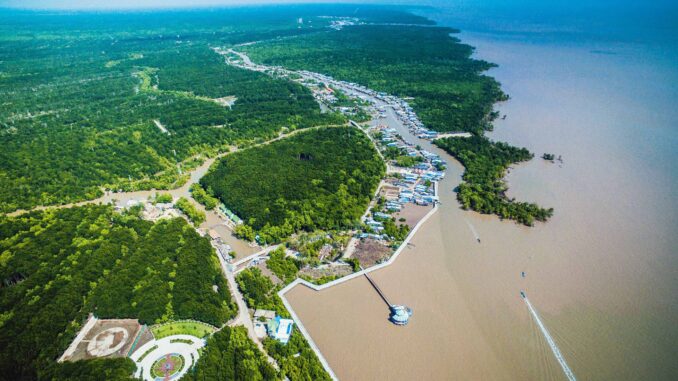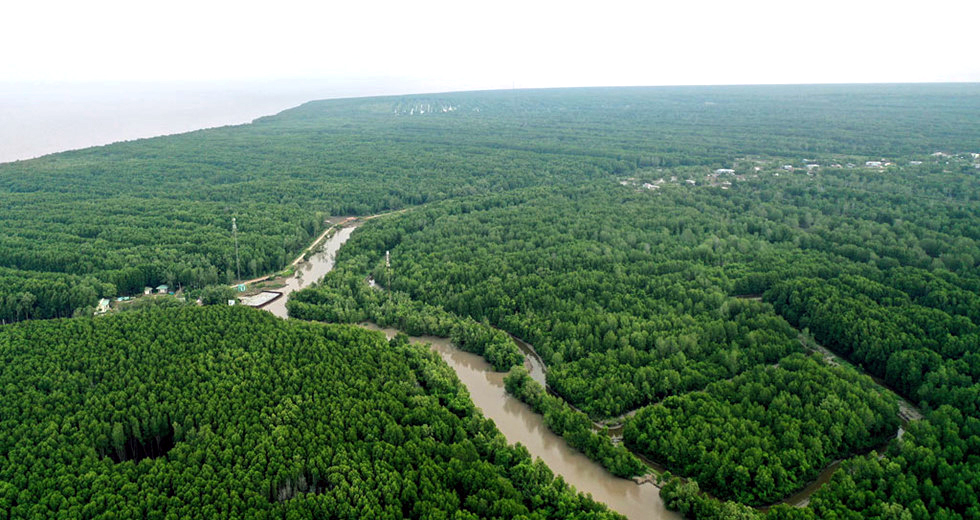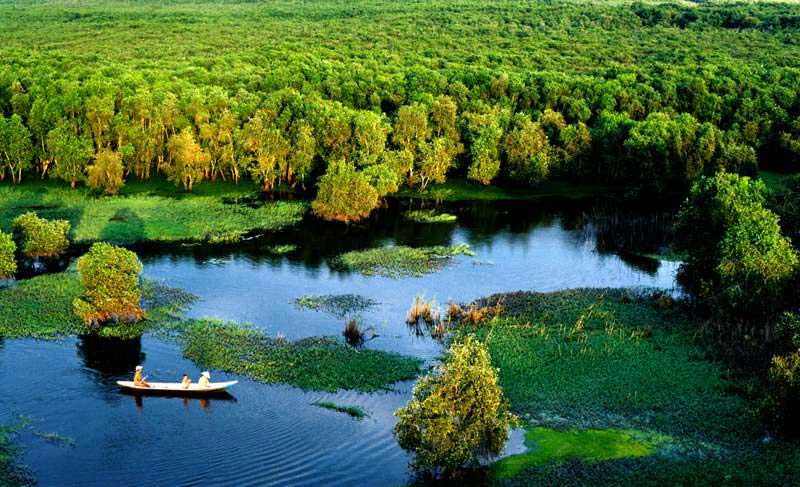
Ca Mau Cape Biosphere Reserve is one of the famous destinations with typical geographical, cultural, and ecological characteristics of the whole country and unique features of special estuaries and coastal eco-regions. Ca Mau Cape is also a sacred place in the hearts of every Vietnamese, everyone wants to set foot on the southernmost point on the mainland of the country. In that sacred land, you will once touch a proud landmark of sovereignty, or stand on an iconic ship heading straight to the East Vietnam Sea.
Location
It is located in 6 districts Dam Doi, Phu Tan, Tran Van Thoi, U Minh, Ngoc Hien, and Nam Can. The total area of the biosphere reserve is 371,506 hectares, divided into three main subdivisions:
– The core area has an area of 17,329 hectares
– The buffer zone has an area of 43,309 hectares
– The transition area has an area of 310,868 hectares
The core area is also divided into three smaller, strictly protected subdivisions, including Ca Mau Cape National Park, U Minh Ha National Park, and Coastal Protection Forest Range.
Diverse ecosystem
1. Ca Mau Cape National Park
Ca Mau Cape National Park was formed in 2002 with a total area of 41,862 hectares. The National Park is located in the swamp of the Biosphere Reserve, with 36% land area and 64% coastal area, in the two districts of Nam Can and Ngoc Hien.
Ca Mau Cape National Park possesses an ecological system with four characteristics including a Primary successional area on alluvial land, a Mangrove ecosystem transition area, a freshwater Melaleuca forest area, and an area of spawning grounds and raising young aquatic species.
By April 2013, Ca Mau Cape National Park was recognized as the 2nd Ramsar site in the Mekong Delta and the 5th in Vietnam. Ramsar sites need to meet international convention standards on the conservation and rational use of wetlands and are also the habitat of rare Ramsar waterbirds.

By April 2013, Ca Mau Cape National Park was recognized as the 2nd Ramsar site in the Mekong Delta and the 5th in Vietnam. Ramsar sites need to meet international convention standards on the conservation and rational use of wetlands and are also the habitat of rare Ramsar waterbirds. Besides, the National Park is also the area that owns the most diverse ecosystem in the Mui Ca Mau World Biosphere Reserve.
This place has a very large area of Ca Mau mangrove forest with 93 species of plants belonging to 38 families, mainly mangroves. Next are 28 mammal species belonging to 13 families, 6 amphibian species belonging to 4 families, and an additional 34 reptile species belonging to 14 families. Many rare animal and plant species here have been recorded in the Vietnam Red Book and the World Red Book (IUCN). In addition, this place is also the habitat of 74 species of birds belonging to 23 families and 28 species of rare migratory birds.
Mui Ca Mau National Park is currently one of the important areas under the National Conservation Program on Biodiversity. At the same time, this is also a place where scientists often come to research the characteristics of coastal waterbirds in Vietnam in particular and the Asia-Pacific region in general.
The world biosphere reserve of Mui Ca Mau is not only an ecological conservation goal but also suitable for developing unique types of tourism. In addition to the strict scientific research area, the National Park is also open to everyone to visit the wild animal breeding area, play and entertainment at Dat Mui Cultural Park, and many other interesting activities.
2. U Minh Ha National Park
This place also belongs to the Ca Mau Cape World Biosphere Reserve with a total area of 8,286 hectares. This National Park is located in Khanh Lam and Khanh An communes (in U Minh district) and Tran Hoi and Khanh Binh Tay Bac communes (in Tran Van Thoi district). U Minh Ha National Park is divided into three main subdivisions, including a forest ecosystem conservation area on peat land, an area for restoration and sustainable use of the flooded forest ecosystem, and an administrative service area.

When established, U Minh Ha National Park was merged with Vo Doi Conservation Area to better preserve and regenerate the values of landscape, nature, environment, ecosystem, and biodiversity. This place is currently home to about 176 plant species, of which Melaleuca accounts for the largest number.
Characteristics of Melaleuca forests

The special-use protective forest area in coastal Ca Mau is a place of extension and transition between mangrove and freshwater ecosystems, forming unique landscapes. The forest has a rich flora and fauna, the most dominant species being black mangrove, white fish sauce, blackfish sauce, guava fish sauce, and parakeets. The plant population is characterized by a mixture of mangrove trees, parrot trees, and fish sauce forests.
Coastal special-use forests are natural belts with a very important role in maintaining and protecting land and ecosystems. This area often experiences natural disasters, storms, and floods, so protective forests play an even greater role, helping to maintain and create balance for the environment and protecting animals, plants, and people.
UNESCO recognition
Ca Mau Cape Biosphere Reserve was recognized by UNESCO on May 26, 2009. The Ca Mau Cape Biosphere Reserve stands as a beacon of natural beauty and ecological significance, a sanctuary for life amidst the bustling human world. Its diverse landscapes, rich biodiversity, and vital ecosystem services make it a treasure trove of natural heritage worthy of global recognition and protection.
Conclusion
From the sprawling mangrove forests that preserve the coastline to the teeming wetlands that nurture a multitude of species, the reserve is a testament to the interconnectedness of nature. It is a living tapestry of interconnected ecosystems, each playing a crucial role in maintaining the delicate balance of life in the region.
The Ca Mau Cape Biosphere Reserve is not merely a haven for plants and animals; it is also home to communities whose lives are inextricably linked to the land. The reserve’s inhabitants have a deep understanding of the natural world, a legacy passed down through generations of living in harmony with the environment.
Get an opportunity to visit the Global Biosphere Reserve in Vietnam through Vietnam E-Visa!